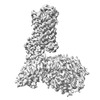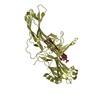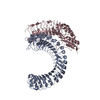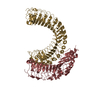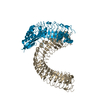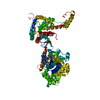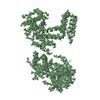+ データを開く
データを開く
- 基本情報
基本情報
| 登録情報 | データベース: EMDB / ID: EMD-25819 | ||||||||||||
|---|---|---|---|---|---|---|---|---|---|---|---|---|---|
| タイトル | Lysophosphatidic acid receptor 1-Gi complex bound to LPA | ||||||||||||
 マップデータ マップデータ | |||||||||||||
 試料 試料 |
| ||||||||||||
| 機能・相同性 |  機能・相同性情報 機能・相同性情報Adenylate cyclase inhibitory pathway / cellular response to 1-oleoyl-sn-glycerol 3-phosphate / lysophosphatidic acid receptor activity / positive regulation of smooth muscle cell chemotaxis / Adrenaline,noradrenaline inhibits insulin secretion / ADP signalling through P2Y purinoceptor 12 / Lysosphingolipid and LPA receptors / : / lysophosphatidic acid binding / Extra-nuclear estrogen signaling ...Adenylate cyclase inhibitory pathway / cellular response to 1-oleoyl-sn-glycerol 3-phosphate / lysophosphatidic acid receptor activity / positive regulation of smooth muscle cell chemotaxis / Adrenaline,noradrenaline inhibits insulin secretion / ADP signalling through P2Y purinoceptor 12 / Lysosphingolipid and LPA receptors / : / lysophosphatidic acid binding / Extra-nuclear estrogen signaling / Olfactory Signaling Pathway / Sensory perception of sweet, bitter, and umami (glutamate) taste / Synthesis, secretion, and inactivation of Glucagon-like Peptide-1 (GLP-1) / negative regulation of cilium assembly / G alpha (i) signalling events / regulation of synaptic vesicle cycle / corpus callosum development / bleb assembly / oligodendrocyte development / cellular response to oxygen levels / Activation of the phototransduction cascade / regulation of metabolic process / negative regulation of cAMP-mediated signaling / regulation of postsynaptic neurotransmitter receptor internalization / GTPase activating protein binding / negative regulation of synaptic transmission / Activation of G protein gated Potassium channels / G-protein activation / G beta:gamma signalling through PI3Kgamma / Prostacyclin signalling through prostacyclin receptor / G beta:gamma signalling through PLC beta / ADP signalling through P2Y purinoceptor 1 / Thromboxane signalling through TP receptor / Presynaptic function of Kainate receptors / G beta:gamma signalling through CDC42 / Inhibition of voltage gated Ca2+ channels via Gbeta/gamma subunits / Glucagon-type ligand receptors / Adrenaline,noradrenaline inhibits insulin secretion / G alpha (12/13) signalling events / G beta:gamma signalling through BTK / ADP signalling through P2Y purinoceptor 12 / Cooperation of PDCL (PhLP1) and TRiC/CCT in G-protein beta folding / Thrombin signalling through proteinase activated receptors (PARs) / Ca2+ pathway / G alpha (z) signalling events / Extra-nuclear estrogen signaling / G alpha (s) signalling events / G alpha (q) signalling events / optic nerve development / G alpha (i) signalling events / Glucagon-like Peptide-1 (GLP1) regulates insulin secretion / Vasopressin regulates renal water homeostasis via Aquaporins / positive regulation of Rho protein signal transduction / positive regulation of dendritic spine development / : / G-protein alpha-subunit binding / GABA-ergic synapse / positive regulation of protein localization to cell cortex / regulation of cAMP-mediated signaling / D2 dopamine receptor binding / G protein-coupled serotonin receptor binding / regulation of mitotic spindle organization / cellular response to forskolin / positive regulation of stress fiber assembly / adenylate cyclase-inhibiting G protein-coupled receptor signaling pathway / myelination / cerebellum development / neurogenesis / cell chemotaxis / dendritic shaft / G protein-coupled receptor activity / G protein-coupled receptor binding / PDZ domain binding / G-protein beta/gamma-subunit complex binding / adenylate cyclase-modulating G protein-coupled receptor signaling pathway / adenylate cyclase-activating G protein-coupled receptor signaling pathway / photoreceptor disc membrane / cellular response to catecholamine stimulus / adenylate cyclase-activating dopamine receptor signaling pathway / cellular response to prostaglandin E stimulus / GDP binding / G-protein beta-subunit binding / heterotrimeric G-protein complex / signaling receptor complex adaptor activity / negative regulation of neuron projection development / presynaptic membrane / cell cortex / midbody / regulation of cell shape / G alpha (i) signalling events / positive regulation of cytosolic calcium ion concentration / G alpha (q) signalling events / postsynaptic membrane / positive regulation of canonical NF-kappaB signal transduction / positive regulation of MAPK cascade / dendritic spine / endosome / positive regulation of apoptotic process / cell cycle / G protein-coupled receptor signaling pathway 類似検索 - 分子機能 | ||||||||||||
| 生物種 |   Homo sapiens (ヒト) / Homo sapiens (ヒト) /  | ||||||||||||
| 手法 | 単粒子再構成法 / クライオ電子顕微鏡法 / 解像度: 2.83 Å | ||||||||||||
 データ登録者 データ登録者 | Liu S / Paknejad N / Zhu L / Kihara Y / Ray D / Chun J / Liu W / Hite RK / Huang XY | ||||||||||||
| 資金援助 |  米国, 3件 米国, 3件
| ||||||||||||
 引用 引用 |  ジャーナル: Nat Commun / 年: 2022 ジャーナル: Nat Commun / 年: 2022タイトル: Differential activation mechanisms of lipid GPCRs by lysophosphatidic acid and sphingosine 1-phosphate. 著者: Shian Liu / Navid Paknejad / Lan Zhu / Yasuyuki Kihara / Manisha Ray / Jerold Chun / Wei Liu / Richard K Hite / Xin-Yun Huang /  要旨: Lysophospholipids are bioactive lipids and can signal through G-protein-coupled receptors (GPCRs). The best studied lysophospholipids are lysophosphatidic acid (LPA) and sphingosine 1-phosphate (S1P). ...Lysophospholipids are bioactive lipids and can signal through G-protein-coupled receptors (GPCRs). The best studied lysophospholipids are lysophosphatidic acid (LPA) and sphingosine 1-phosphate (S1P). The mechanisms of lysophospholipid recognition by an active GPCR, and the activations of lysophospholipid GPCR-G-protein complexes remain unclear. Here we report single-particle cryo-EM structures of human S1P receptor 1 (S1P) and heterotrimeric G complexes formed with bound S1P or the multiple sclerosis (MS) treatment drug Siponimod, as well as human LPA receptor 1 (LPA) and G complexes in the presence of LPA. Our structural and functional data provide insights into how LPA and S1P adopt different conformations to interact with their cognate GPCRs, the selectivity of the homologous lipid GPCRs for S1P versus LPA, and the different activation mechanisms of these GPCRs by LPA and S1P. Our studies also reveal specific optimization strategies to improve the MS-treating S1P-targeting drugs. | ||||||||||||
| 履歴 |
|
- 構造の表示
構造の表示
| ムービー |
 ムービービューア ムービービューア |
|---|---|
| 構造ビューア | EMマップ:  SurfView SurfView Molmil Molmil Jmol/JSmol Jmol/JSmol |
| 添付画像 |
- ダウンロードとリンク
ダウンロードとリンク
-EMDBアーカイブ
| マップデータ |  emd_25819.map.gz emd_25819.map.gz | 10.1 MB |  EMDBマップデータ形式 EMDBマップデータ形式 | |
|---|---|---|---|---|
| ヘッダ (付随情報) |  emd-25819-v30.xml emd-25819-v30.xml emd-25819.xml emd-25819.xml | 14.2 KB 14.2 KB | 表示 表示 |  EMDBヘッダ EMDBヘッダ |
| 画像 |  emd_25819.png emd_25819.png | 89.4 KB | ||
| アーカイブディレクトリ |  http://ftp.pdbj.org/pub/emdb/structures/EMD-25819 http://ftp.pdbj.org/pub/emdb/structures/EMD-25819 ftp://ftp.pdbj.org/pub/emdb/structures/EMD-25819 ftp://ftp.pdbj.org/pub/emdb/structures/EMD-25819 | HTTPS FTP |
-検証レポート
| 文書・要旨 |  emd_25819_validation.pdf.gz emd_25819_validation.pdf.gz | 336.3 KB | 表示 |  EMDB検証レポート EMDB検証レポート |
|---|---|---|---|---|
| 文書・詳細版 |  emd_25819_full_validation.pdf.gz emd_25819_full_validation.pdf.gz | 335.8 KB | 表示 | |
| XML形式データ |  emd_25819_validation.xml.gz emd_25819_validation.xml.gz | 6.5 KB | 表示 | |
| CIF形式データ |  emd_25819_validation.cif.gz emd_25819_validation.cif.gz | 7.4 KB | 表示 | |
| アーカイブディレクトリ |  https://ftp.pdbj.org/pub/emdb/validation_reports/EMD-25819 https://ftp.pdbj.org/pub/emdb/validation_reports/EMD-25819 ftp://ftp.pdbj.org/pub/emdb/validation_reports/EMD-25819 ftp://ftp.pdbj.org/pub/emdb/validation_reports/EMD-25819 | HTTPS FTP |
-関連構造データ
- リンク
リンク
| EMDBのページ |  EMDB (EBI/PDBe) / EMDB (EBI/PDBe) /  EMDataResource EMDataResource |
|---|---|
| 「今月の分子」の関連する項目 |
- マップ
マップ
| ファイル |  ダウンロード / ファイル: emd_25819.map.gz / 形式: CCP4 / 大きさ: 64 MB / タイプ: IMAGE STORED AS FLOATING POINT NUMBER (4 BYTES) ダウンロード / ファイル: emd_25819.map.gz / 形式: CCP4 / 大きさ: 64 MB / タイプ: IMAGE STORED AS FLOATING POINT NUMBER (4 BYTES) | ||||||||||||||||||||||||||||||||||||||||||||||||||||||||||||||||||||
|---|---|---|---|---|---|---|---|---|---|---|---|---|---|---|---|---|---|---|---|---|---|---|---|---|---|---|---|---|---|---|---|---|---|---|---|---|---|---|---|---|---|---|---|---|---|---|---|---|---|---|---|---|---|---|---|---|---|---|---|---|---|---|---|---|---|---|---|---|---|
| ボクセルのサイズ | X=Y=Z: 1.064 Å | ||||||||||||||||||||||||||||||||||||||||||||||||||||||||||||||||||||
| 密度 |
| ||||||||||||||||||||||||||||||||||||||||||||||||||||||||||||||||||||
| 対称性 | 空間群: 1 | ||||||||||||||||||||||||||||||||||||||||||||||||||||||||||||||||||||
| 詳細 | EMDB XML:
CCP4マップ ヘッダ情報:
| ||||||||||||||||||||||||||||||||||||||||||||||||||||||||||||||||||||
-添付データ
- 試料の構成要素
試料の構成要素
-全体 : complex of Lysophosphatidic Acid Receptor 1 with G-protein and LPA
| 全体 | 名称: complex of Lysophosphatidic Acid Receptor 1 with G-protein and LPA |
|---|---|
| 要素 |
|
-超分子 #1: complex of Lysophosphatidic Acid Receptor 1 with G-protein and LPA
| 超分子 | 名称: complex of Lysophosphatidic Acid Receptor 1 with G-protein and LPA タイプ: complex / キメラ: Yes / ID: 1 / 親要素: 0 / 含まれる分子: #1-#4 |
|---|---|
| 由来(天然) | 生物種:  |
-分子 #1: Lysophosphatidic acid receptor 1
| 分子 | 名称: Lysophosphatidic acid receptor 1 / タイプ: protein_or_peptide / ID: 1 / コピー数: 1 / 光学異性体: LEVO |
|---|---|
| 由来(天然) | 生物種:  Homo sapiens (ヒト) Homo sapiens (ヒト) |
| 分子量 | 理論値: 39.734605 KDa |
| 組換発現 | 生物種:  |
| 配列 | 文字列: DYKDDDDKAA AAAISTSIPV ISQPQFTAMN EPQCFYNESI AFFYNRSGKH LATEWNTVSK LVMGLGITVC IFIMLANLLV MVAIYVNRR FHFPIYYLMA NLAAADFFAG LAYFYLMFNT GPNTRRLTVS TWLLRQGLID TSLTASVANL LAIAIERHIT V FRMQLHTR ...文字列: DYKDDDDKAA AAAISTSIPV ISQPQFTAMN EPQCFYNESI AFFYNRSGKH LATEWNTVSK LVMGLGITVC IFIMLANLLV MVAIYVNRR FHFPIYYLMA NLAAADFFAG LAYFYLMFNT GPNTRRLTVS TWLLRQGLID TSLTASVANL LAIAIERHIT V FRMQLHTR MSNRRVVVVI VVIWTMAIVM GAIPSVGWNC ICDIENCSNM APLYSDSYLV FWAIFNLVTF VVMVVLYAHI FG YVRQRTM RMSRHSSGPR RNRDTMMSLL KTVVIVLGAF IICWTPGLVL LLLDVCCPQC DVLAYEKFFL LLAEFNSAMN PII YSYRDK EMSATFRQIL CCQRSENPTG PTEG |
-分子 #2: Guanine nucleotide-binding protein G(I)/G(S)/G(T) subunit beta-1
| 分子 | 名称: Guanine nucleotide-binding protein G(I)/G(S)/G(T) subunit beta-1 タイプ: protein_or_peptide / ID: 2 / コピー数: 1 / 光学異性体: LEVO |
|---|---|
| 由来(天然) | 生物種:  |
| 分子量 | 理論値: 37.41693 KDa |
| 組換発現 | 生物種:  |
| 配列 | 文字列: MSELDQLRQE AEQLKNQIRD ARKACADATL SQITNNIDPV GRIQMRTRRT LRGHLAKIYA MHWGTDSRLL VSASQDGKLI IWDSYTTNK VHAIPLRSSW VMTCAYAPSG NYVACGGLDN ICSIYNLKTR EGNVRVSREL AGHTGYLSCC RFLDDNQIVT S SGDTTCAL ...文字列: MSELDQLRQE AEQLKNQIRD ARKACADATL SQITNNIDPV GRIQMRTRRT LRGHLAKIYA MHWGTDSRLL VSASQDGKLI IWDSYTTNK VHAIPLRSSW VMTCAYAPSG NYVACGGLDN ICSIYNLKTR EGNVRVSREL AGHTGYLSCC RFLDDNQIVT S SGDTTCAL WDIETGQQTT TFTGHTGDVM SLSLAPDTRL FVSGACDASA KLWDVREGMC RQTFTGHESD INAICFFPNG NA FATGSDD ATCRLFDLRA DQELMTYSHD NIICGITSVS FSKSGRLLLA GYDDFNCNVW DALKADRAGV LAGHDNRVSC LGV TDDGMA VATGSWDSFL KIWN |
-分子 #3: Guanine nucleotide-binding protein G(i) subunit alpha-1
| 分子 | 名称: Guanine nucleotide-binding protein G(i) subunit alpha-1 タイプ: protein_or_peptide / ID: 3 / コピー数: 1 / 光学異性体: LEVO |
|---|---|
| 由来(天然) | 生物種:  |
| 分子量 | 理論値: 43.16307 KDa |
| 組換発現 | 生物種:  |
| 配列 | 文字列: MGSSHHHHHH SSGLEVLFQG PHMASMGCTL SAEDKAAVER SKMIDRNLRE DGEKAAREVK LLLLGAGESG KSTIVKQMKI IHEAGYSEE ECKQYKAVVY SNTIQSIIAI IRAMGRLKID FGDSARADDA RQLFVLAGAA EEGFMTAELA GVIKRLWKDS G VQACFNRS ...文字列: MGSSHHHHHH SSGLEVLFQG PHMASMGCTL SAEDKAAVER SKMIDRNLRE DGEKAAREVK LLLLGAGESG KSTIVKQMKI IHEAGYSEE ECKQYKAVVY SNTIQSIIAI IRAMGRLKID FGDSARADDA RQLFVLAGAA EEGFMTAELA GVIKRLWKDS G VQACFNRS REYQLNDSAA YYLNDLDRIA QPNYIPTQQD VLRTRVKTTG IVETHFTFKD LHFKMFDVGA QRSERKKWIH CF EGVTAII FCVALSDYDL VLAEDEEMNR MHESMKLFDS ICNNKWFTDT SIILFLNKKD LFEEKIKKSP LTICYPEYAG SNT YEEAAA YIQCQFEDLN KRKDTKEIYT HFTCATDTKN VQFVFDAVTD VIIKNNLKDC GLF |
-分子 #4: Guanine nucleotide-binding protein G(I)/G(S)/G(O) subunit gamma-2
| 分子 | 名称: Guanine nucleotide-binding protein G(I)/G(S)/G(O) subunit gamma-2 タイプ: protein_or_peptide / ID: 4 / コピー数: 1 / 光学異性体: LEVO |
|---|---|
| 由来(天然) | 生物種:  |
| 分子量 | 理論値: 7.845078 KDa |
| 組換発現 | 生物種:  |
| 配列 | 文字列: MASNNTASIA QARKLVEQLK MEANIDRIKV SKAAADLMAY CEAHAKEDPL LTPVPASENP FREKKFFSAI L |
-分子 #5: (2R)-2-hydroxy-3-(phosphonooxy)propyl (9E)-octadec-9-enoate
| 分子 | 名称: (2R)-2-hydroxy-3-(phosphonooxy)propyl (9E)-octadec-9-enoate タイプ: ligand / ID: 5 / コピー数: 1 / 式: NKP |
|---|---|
| 分子量 | 理論値: 436.52 Da |
| Chemical component information | 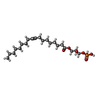 ChemComp-NKP: |
-実験情報
-構造解析
| 手法 | クライオ電子顕微鏡法 |
|---|---|
 解析 解析 | 単粒子再構成法 |
| 試料の集合状態 | particle |
- 試料調製
試料調製
| 緩衝液 | pH: 7 |
|---|---|
| 凍結 | 凍結剤: ETHANE |
- 電子顕微鏡法
電子顕微鏡法
| 顕微鏡 | FEI TITAN KRIOS |
|---|---|
| 撮影 | フィルム・検出器のモデル: GATAN K3 (6k x 4k) / 平均電子線量: 28.2 e/Å2 |
| 電子線 | 加速電圧: 300 kV / 電子線源:  FIELD EMISSION GUN FIELD EMISSION GUN |
| 電子光学系 | 照射モード: FLOOD BEAM / 撮影モード: BRIGHT FIELD / 最大 デフォーカス(公称値): 2.2 µm / 最小 デフォーカス(公称値): 0.8 µm |
| 実験機器 |  モデル: Titan Krios / 画像提供: FEI Company |
- 画像解析
画像解析
| 最終 再構成 | 解像度のタイプ: BY AUTHOR / 解像度: 2.83 Å / 解像度の算出法: FSC 0.143 CUT-OFF / 使用した粒子像数: 1588791 |
|---|---|
| 初期 角度割当 | タイプ: MAXIMUM LIKELIHOOD |
| 最終 角度割当 | タイプ: MAXIMUM LIKELIHOOD |
 ムービー
ムービー コントローラー
コントローラー



